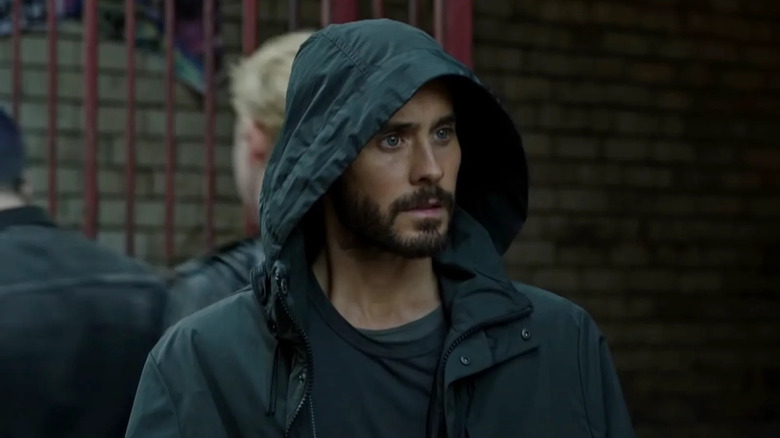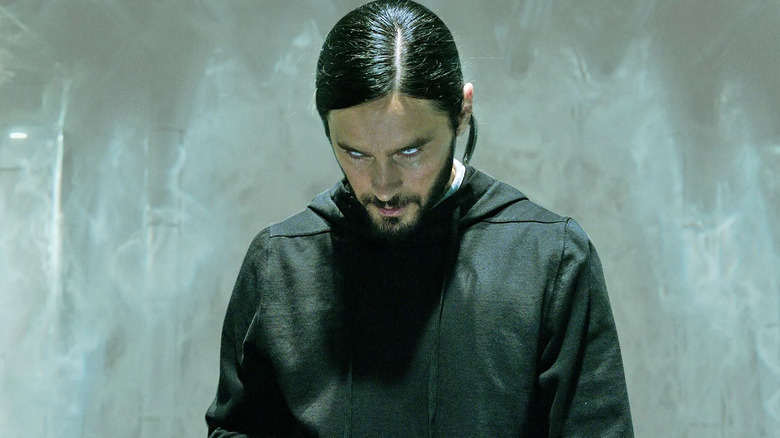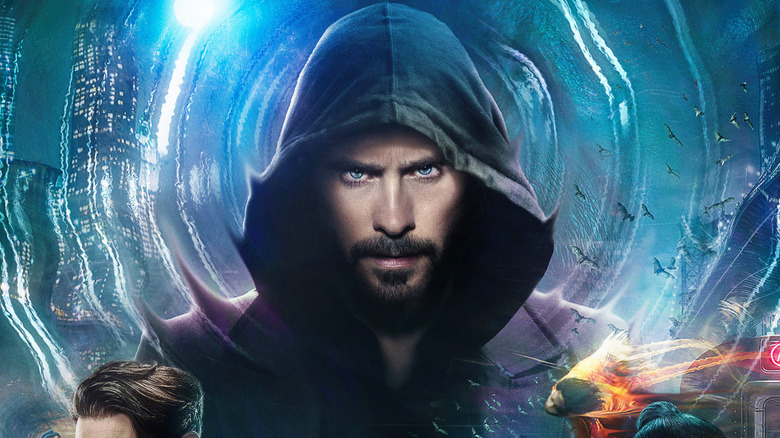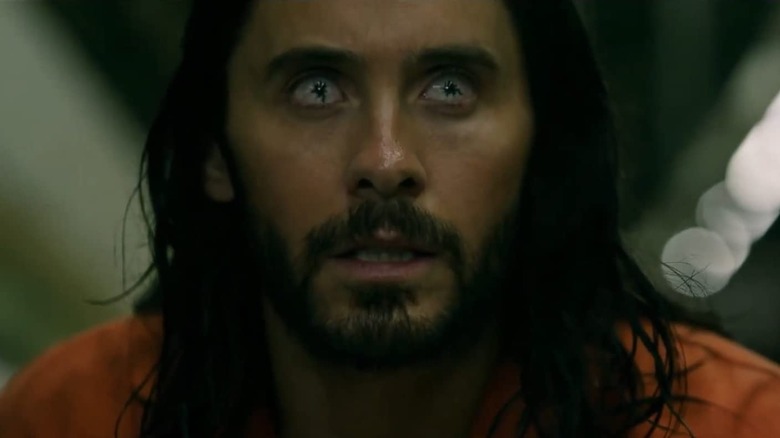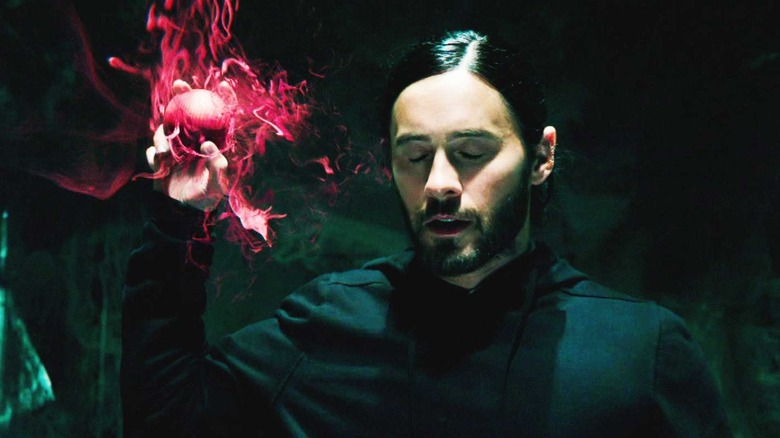The Five Coolest Easter Eggs In Morbius
This article contains spoilers, major and minor, for "Morbius."
"Morbius" opened last week to modest financial success and shrugs from critics. The adventures of Marvel's Living Vampire didn't inspire quite the same passion as "Spider-Man: No Way Home" — to which "Morbius" is tentatively connected; more on that in a moment — but it was not going to pass idly by without multiple references to its comic book source material or to other Marvel comics. The central thrill of comic book movies — at least as the trend currently dictates — is their interconnectivity; no single comic book movie will ever stand on its own again without implying that there is a larger, vaster universe out there full of characters our protagonist will eventually interact with. Most Marvel movies serve as advertisements for the next adventure (brilliant, from a marketing perspective).
"Morbius" was not the film to buck the trend, and has several cute references throughout, either to whet your appetite for future character interactions, or to merely elicit a grateful titter of recognition. Here are a few this author spotted.
The school for gifted youngsters
Michael Morbius has been suffering from a rare and unnamed blood condition since childhood, and requires multiple blood transfusions a day. He is also a tech genius, as is displayed when a nearby friend, also suffering from the same ailment and in the midst of going through a blood transfusion, requires a quick fix on his malfunctioning transfusion machine. Michael is able to repair the machine using the spring from inside his retractable ball point pen.
This sudden burst of engineering acumen is noticed by his supervising doctor (Jared Harris), who immediately recognizes that Morbius is a gifted child. Harris knows about a special school in New York where Morbius may be able to study alongside other gifted students. The phrase Harris uses is "a school for gifted youngsters."
The phrase may sound innocuous to the untrained ear, but fans of "X-Men" comics will recognize it immediately. The Charles Xavier School of Gifted Youngsters, while an actual school, was in fact a school for superpowered mutants and front for the X-Men's crimefighting lair. Because mutants are forced to hide from the public in the world of Marvel comics, it's possible that the Harris character (rightly) assumed it was merely a school for gifted students.
You wouldn't like me when I'm hungry
Morbius (Jared Leto) grows up, injects himself with vampire bat DNA and becomes Batman. I mean, Morbius the Living Vampire. Immediately after doing so, he attacks and drinks the blood of a cadre of mercenaries he has (bafflingly) hired to oversee his treatment (DNA experiments are illegal, and he can only conduct them on a ship floating in international waters). In so doing, Morbius attracts the attention of a pair of Federal agents who will spend the remainder of the film on his trail. Eventually, perhaps predictably, the Feds apprehend Morbius for a tête-à-tête back at the station.
During said tête-à-tête, Morbius finds his bloodthirst rising. Drinking blood staves off his more monstrous instincts, and real human blood seems to work better than the synthetic blood Morbius had invented. Handcuffed to the table, Morbius becomes agitated, nervous that he'll break free with his superhuman strength and attack the Feds in the room and drink their blood. The Feds notice that he is getting nervous. "I'm hungry," he says. "You wouldn't like me when I'm hungry."
This is a twofold reference to The Hulk. The Hulk transforms into a massive, green radioactive rage monster when he gets angry (and he's always angry). "You wouldn't like me when I'm angry" is the cryptic warning Bruce Banner (or David Banner in the 1970s TV series) would give to any potential victims. Additionally, "You wouldn't like me when I'm hungry" was a quote from the 2008 Louis Leterrier film "The Incredible Hulk," wherein Bruce Banner (Edward Norton) tried to give his traditional warning in Spanish. Since he hadn't yet mastered the language, however, he said "hungry" instead of "angry." A cute joke, even if the Spanish word for "angry" (enfadado) doesn't sound like the Spanish word for "hungry" (hambriento).
I am Venom
There are a few references in "Morbius" to the films "Venom" (the 2018 Tom Hardy film, not the 1981 Klaus Kinski film) and its sequel "Venom: Let There Be Carnage."
Morbius has a childhood friend (Matt Smith) who was suffering from the same blood ailment. When Smith's character also injects himself with vampire bat DNA, the two (without much explanation) become vampire rivals, with the former friend embracing his newfound monstrousness, and happy to kill others in order to survive. Multiple stories of exsanguinated corpses begin appearing in the local newspapers, leading a supporting character to comment that these murders are almost as bizarre as the monster-related deaths in San Francisco ... the city where "Venom" takes place.
There is also a scene later in "Morbius" wherein Michael infiltrates an underground lair where counterfeit money is being printed. Knowing that such a lair is unknown to the police, Morbius elects to scare off the counterfeiters and steal their lair to use for his own research purposes. In order to frighten them, he lunges at them with his vampire fangs akimbo. "Who are you?" they scream. "I am Venom," Morbius says back. They run.
In the final cut of the film, that was the end of the scene. In the trailers for "Morbius," however, there was an additional line of dialogue after "I am Venom." Morbius retracts his fangs, smiles, and, in a self-effacing manner, says "Nah, I'm just kidding. It's Dr. Michael Morbius, at your service." Maybe not the wisest thing to say to a criminal when you're trying to hide out from the Feds, but a nicer way to end the scene. Otherwise, why is Morbius declaring himself to be Venom?
The Daily Bugle and other Spider-Man stuff
The character of Morbius first appeared in Spider-Man comics in the early 1970s, and he has been associated with Spider-Man ever since (despite dallying with Ghost Rider and other demonic Marvel characters from time to time). Sonys, the studio behind "Morbius," owns the film rights to Spider-Man and hundreds of his ancillary villains and allies, hence the following Spider-Man references making their way into the adventures of the Living Vampire.
There is a scene wherein a character is reading The Daily Bugle, which is the name of the newspaper where Peter Parker (that's Spider-Man) works to make ends meet.
There are two mid-credits epilogues in "Morbius" which refer to the films "Spider-Man: Homecoming" (2017) and "Spider-Man: No Way Home" (2021). In the epilogues, a giant cosmic rift appears in the sky, a bizarre sight if one wasn't able to identify it. This was the rift opened by Doctor Strange in "No Way Home," which allowed supervillains from other movies to infiltrate this particular continuity. As such, one such villain, Adrian Toomes (Michael Keaton) appears in a jail cell. Toomes, better known as The Vulture, caused problems for Spider-Man in "Homecoming," and now seems to be stranded in the Morbius dimension. In a secondary epilogue, Toomes appears to Morbius — this time in his full Vulture regalia (and how the outfit made its way into the Morbius universe is not explained) — to request a team-up.
Working knowledge of previous Spider-Man movies will aid in understanding all this. But know this: The homework is just going to get more complicated from here on out.
